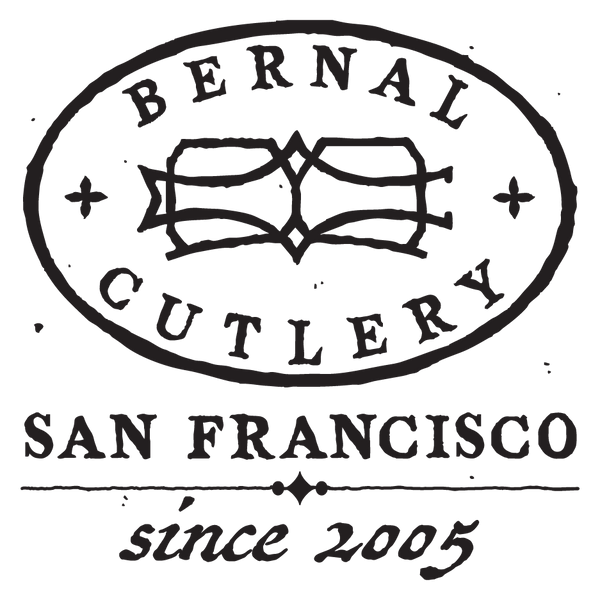That Day I Grabbed a 12" Chefs Knife
January 7, 2025 – Josh Donald
Happy New Year everyone! I want to wish you all a healthy, happy 2025. Hoping it is a big year in the best of ways, and in that spirit, may I offer the following:
I recently pulled the 12” chef knife off one of the knife magnets in my kitchen, which doesn't often happen. Sure, if there was an extra large winter squash to cleave or a freak orgy of sauerkraut-making, then yes, but day to day, it's generally getting ignored. Having a 12” chef knife at home is weird, and having one in a professional knife roll is also weird. Most people don’t have a 10” chef knife at home, much less a 12”, and these days, many professionals might not have chef knives larger than 8.5”.
That day I grabbed the 12” chef knife and cut a loaf of bread. It sailed through straight and strong, it didn’t whine about the bottom crust or need reassurance. It went straight through, and was hungry for more. I decided right there I was going to make this my regular knife for all knife-related jobs for a week, ‘give it a bit of bollocks’ would be my mantra. I used it on everything including but not limited to more loaves of bread, garlic, onions, broccoli, a steak, splitting English muffins, peeling cucumbers, cutting sandwiches, zucchini, ginger, cheese, fine-slicing green onions and cutting a pizza. The work was always done before I felt like I was done, it was great using something with its power. Some things were a little silly, admittedly and I could have used a better knife (minced garlic), but it was possible, and I stuck to my weird pledge.
My 12” chef knife is a French ‘Ideal’ pattern with a hand-forged carbon steel blade, and the archetypal black POM (plastic) handles made possibly from the 1960s to early 90s. This combination of carbon steel and POM composite is kind of an Ur-Sabatier, exactly the type Julia Childs famously ‘chop-chopped’ with, and is still in production, we get them in carbon and POM with brass rivets from the venerable K Sabatier in Thiers.
My grandfather had a gold Buick Mercury in the 1970s that had big wide bench seats (also gold) and a distinct smell that was equal parts gasoline, Pinot Clubman aftershave, cigarettes, and denture-friendly Freedent mint gum. When you went over 40 miles an hour in that car, it bounced a little bit on its suspension; going on the freeway, it settled into a confident nod of approval and had the feel that it propelled itself. That is what using this knife felt like. Minus the signature Chester Bernard Donald smell or much gold.
12” chef knives used to be a much more common part of a professional’s tool kit. Origin-wise, they span a range of different locals. French, German, and American make are the most commonly found by me vintage knife-wise. The 12” chef knife is the knife of one in charge, either of their station or of the kitchen; it puts the chief in chef. For many volume-oriented tasks, it screams past smaller knives in its ability to blast through a large stack of something vegetal or slice thin something big and animal. It was certainly not the only knife used, but it was part of the armory.
When I got started sharpening professionally 20 years ago, the 10” chef knife was the de-riguer professional chef knife, it seemed most students in culinary school were given one and professional knife rolls that came across my sharpening counter had a 10” chef knife or a similarly sized Japanese knife (240mm or 270mm). Sometimes, this 10” chef clearly had lots of miles on its odometer and should have been retired but still had a space in the roll in a place of pride as the venerated elder. When older cooks would come in for a chef knife, it was almost a given to start showing them 10” and many asked for 12” as well. The vintage and antique 13 and 14” knives I scored would almost always go to one of these grizzled oldtimers. I suspected lines from Dirty Harry ran through their heads too.
These days it is much safer to assume that professionals are looking for a shorter knife, when asking for a chef knife 10” is not the de facto choice. Work for many fine dining cooks has changed over the years and training has changed as well, larger knives are not the starting point, and for many not picked up much. I don’t want to assume that I know anyone’s job or trade better than they do, and demands on knife skills have changed I know, however, when one never gets used to a large knife, it is harder to make a case for picking one up and getting to work with it. My experience as a home cook is that after a few session,s a larger knife starts to feel more comfortable, and the size of a bigger chef knife becomes an asset in most applications rather than a liability.
Ultimately, there is no other way to describe it than to experience it oneself, and because I feel so strongly about how useful this knife is and how great it feels to cut with a grown-ass chef knife we make sure to stock them whenever they are available despite them being the near the best sellers list (yet).
